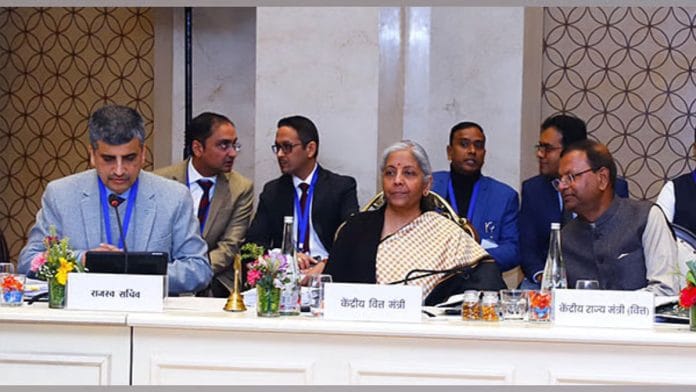Last Saturday, Finance Minister Nirmala Sitharaman chaired a press conference following the conclusion of the 55th GST Council meeting. Through it, she inadvertently created a new term—‘popcorn taxation’—and lakhs of memes.
While this may seem like a trivialisation of GST, it actually lays bare how the system has now rebounded on its initial promise of bringing ease of doing business in the country. The Finance Minister’s four-minute explanation on the taxation of popcorn highlighted how complex the system has become. It shouldn’t take anybody that much time to explain the applicable tax rates on a single product.
Since then, GST has been ridiculed, derided, lamented about, and generally panned by laypeople and even former government officials who worked on its implementation. That is why India’s Goods and Services Tax is ThePrint’s Newsmaker of the Week.
So, what is the issue behind GST on popcorn? You see, as per the taxman, depending on your taste preferences, popcorn can either be a namkeen (salty) or a mithai (sweet) — forget that those two terms have never been used by anyone to refer to popcorn.
Packed, loose & caramelised
Ready-to-eat popcorn, salted and spiced for taste, and sold loosely attracts a GST rate of 5 per cent. That same popcorn, if packaged and labelled, attracts a rate of 12 per cent. One wonders what happens if the vendor tears open the packet and sells loose popcorn to the customer. Perhaps the universe will explode, who knows?
Things get even trickier when you talk about caramel popcorn. Those who prefer this flavour will have to shell out 18 per cent GST, regardless of whether it is packaged or sold loose. Then some head to the movie hall and ask for salted and caramel popcorn mixed together. What happens to them?
Over the week, one particular meme stood out among the lot. It was a picture of salted caramel popcorn packets with questions along the lines of: “What now, taxman?” What now, indeed. Most of the memes were at Sitharaman’s expense, but she’s just the face of the decisions. Every state finance minister at the GST Council is equally responsible, as are all of the civil servants in the various rate fitment committees.
The complexity of the tax system is perhaps best captured by the fact that the GST Council had to deliberate on this issue because GST officials were themselves confused.
“There is no new imposition of any tax in this regard and is merely a clarification as certain field units were demanding different tax rates on the same,” the official press release said. “Therefore, it is a clarification being recommended by the GST Council to settle the disputes arising out of interpretation.”
Spare a thought for the poor customers if the tax officials themselves can’t wrap their heads around taxes on a single product. However, the complexity of the GST system when applied to food products is not a new thing.
ThePrint has previously reported on how the GST rate on food can change based on where you buy it, how you buy it, what its chemical composition is, and sometimes even what temperature it is at.
Businessmen and the common man aren’t the only people ranting about GST. It is now so complicated that even those who designed GST and those who usually refrain from criticising the government also weighed in to lambast the system.
Former Chief Economic Advisor Arvind Subramanian — who held the post from 2014 to 2018 and was involved in the birth of GST as it was implemented — took to X following Sitharaman’s press conference to say: “This is a national tragedy, violating the spirit of the Good & Simple Tax the GST was meant to be.”
“The folly is compounded because instead of at least moving in the direction of simplicity we are veering to greater complexity, difficulty of enforcement & just irrationality,” he added.
His successor, KV Subramanian, was more circumspect, but equally scathing in his X post: “Complexity is a bureaucrat’s delight and citizens’ nightmare”.
The root cause of GST’s complexity lies in the multiplicity of rates. Time and again, experts in the run-up to GST implementation recommended a simple dual-rate system. They were all ignored.
Also read: Why Starlink’s India troubles signal the next big battle for space internet
As far back as 2009, an Empowered Committee of State Finance Ministers recommended that GST should follow a two-rate structure — a lower rate for necessary items and goods of basic importance and a standard rate for goods in general.
Then in 2015, the Arvind Subramanian committee submitted its report on what the GST rates should be. It, too, recommended a dual-rate structure.
What did we get? Right off the bat, GST was launched in 2017 with five rates — 0 per cent, 5 per cent, 12 per cent, 18 per cent, and 28 per cent. This is not counting the various rates at which the compensation cess was levied on items in the 28 per cent slab.
This is what led former Prime Minister Manmohan Singh — a vocal advocate of GST — to castigate the government over it.
“GST is an idea, which had the blessings of the Congress party, but we would have implemented it after due care and adequate preparation,” Singh said in November 2017, in his usual understated yet impactful way. The same month, he lamented that the “loopholes and an ill-designed GST have caused hardships”.
The GST Council has ignored all of this criticism. Believe it or not, GST now actually has nine different rates, with the addition of 0.25 per cent, 1.5 per cent, 3 per cent and 7.5 per cent slabs for particular products.
The council is currently awaiting a report on how to simplify GST. That report can’t come too soon. At the moment, what we have is a mess.
(Edited by Ratan Priya)







Ten-a-penny socialist India got even the GST wrong, ha ha.